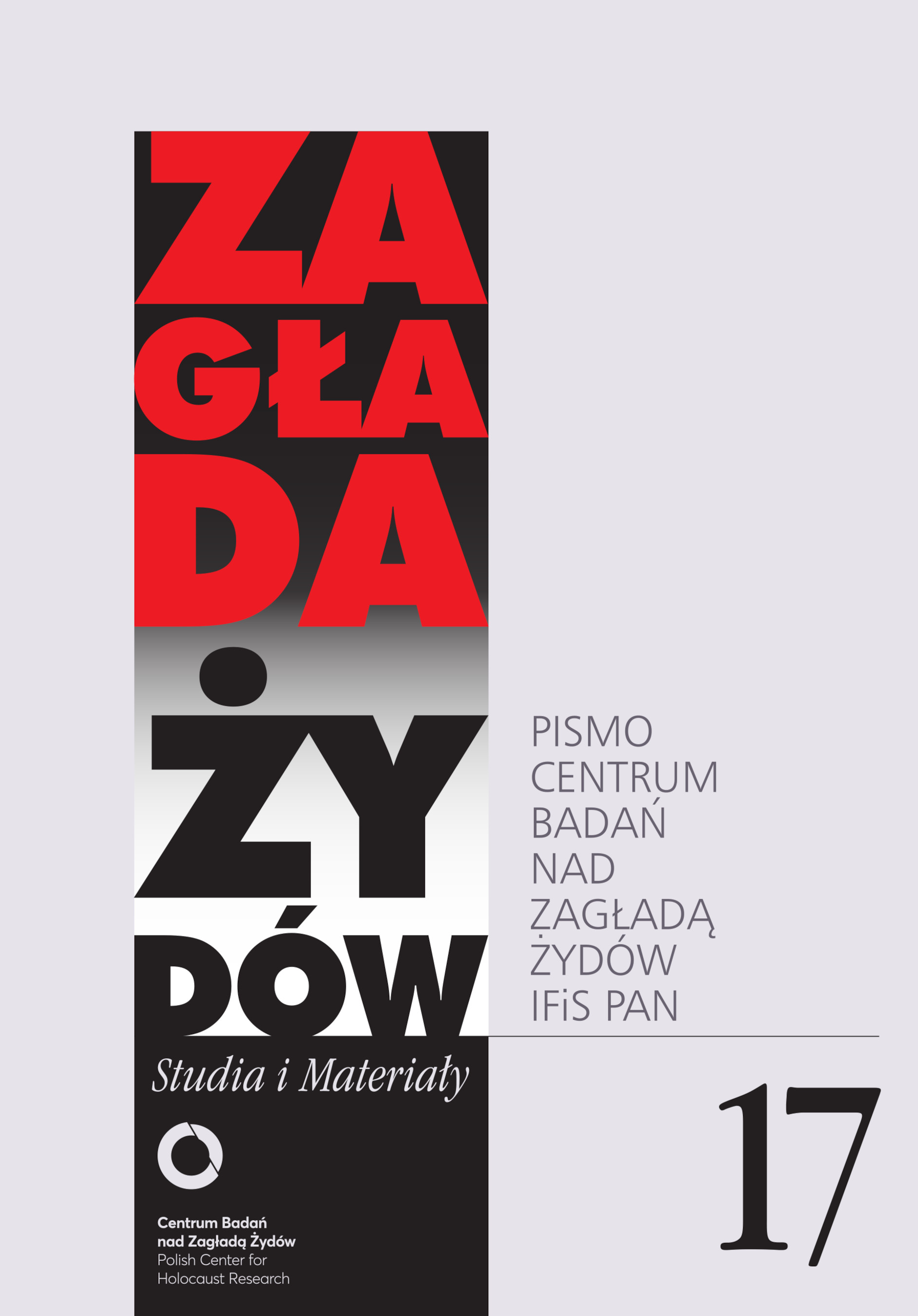What Was Visible Immediately After the War? Forgotten 1940s Images of the Holocaust
Zagłada Żydów. Studia i Materiały, No. 17 (2021), Pages: 202-228
Submission Date: 2021-12-17Publication Date: 2021-12-20
 https://doi.org/10.32927/zzsim.876
https://doi.org/10.32927/zzsim.876
Abstract
This article concerns forgotten short stories, films, and plays written during the first years after the war (1945‒1949) which evoked the chronologically close Holocaust experience. The author ventures a thesis that during that short period emerged representations that touched upon the most difficult aspects of the Holocaust and the relations between the Jewish victims and the ethnically Polish witnesses. The re-articulation of those issues was possible only nowadays. The works which took up the topic of the Polish surroundings’ hostility to the Jews, the appropriation of Jewish property by the Poles and the their compliance in the Holocaust have either been forgotten or – as in the case of movies – their distribution was discontinued. The period immediately after the war facilitates a closer look on the Polish awareness of the wartime and occupation-period events and also shows how the dominant Holocaust narration which was being born at that time obscures those diagnoses.
Keywords
Holocaust memory , postwar period , Filipowicz , Rudnicki , Sandauer , Wohl , Wyszomirski , Zahorska , Zeman
References
Filipowicz Kornel, Krajobraz niewzruszony, Warszawa: Czytelnik, 1948.
Google Scholar
Gross Jan Tomasz, Strach. Antysemityzm w Polsce tuż po wojnie. Historia moralnej zapaści, Kraków: Znak, 2008.
Google Scholar
Gross Jan Tomasz, Upiorna dekada. Eseje o stereotypach na temat Żydów, Polaków, Niemców, komunistów i kolaboracji 1939–1948, Kraków: Austeria, 2007.
Google Scholar
Hering Ludwik, Meta, „Kuźnica” 1945, nr 11; Meta, „Głos Ludu” 1945, nr 279.
Google Scholar
Hering Ludwik, Ślady, „Kuźnica” 1946, nr 12.
Google Scholar
Hurwic-Nowakowska Irena, Żydzi Polscy (1947–1950). Analiza więzi społecznej ludności żydowskiej, Warszawa: Wydawnictwo IFiS PAN, 1996.
Google Scholar
Keff Bożena, Strażnicy fatum, Warszawa: Wydawnictwo Krytyki Politycznej, 2020.
Google Scholar
Krzyżanowski Łukasz, Dom, którego nie było. Powroty ocalałych do powojennego miasta, Wołowiec: Czarne, 2018.
Google Scholar
Lata czterdzieste. Początki polskiej narracji o Zagładzie, red. Maryla Hopfinger i Tomasz Żukowski, Warszawa: Wydawnictwo IBL PAN, 2019.
Google Scholar
Literatura polska wobec Zagłady (1939–1968), red. Sławomir Buryła, Dorota Krawczyńska i Jacek Leociak, Warszawa: Wydawnictwo IBL PAN, 2016.
Google Scholar
Niziołek Grzegorz, Polski teatr Zagłady, Warszawa: Wydawnictwo Krytyki Politycznej i Instytut Teatralny im. Zbigniewa Raszewskiego, 2013.
Google Scholar
Opowieść o niewinności. Kategoria świadka Zagłady w kulturze polskiej (1942–2015), red. Maryla Hopfinger, Tomasz Żukowski, Warszawa: Wydawnictwo IBL PAN, 2018.
Google Scholar
Przeciw antysemityzmowi, wybór, wstęp i oprac. Adam Michnik, t. 2, Kraków: Universitas, 2010.
Google Scholar
Rudnicki Adolf, Szekspir, Warszawa: Spółdzielnia Wydawnicza Książka, 1948.
Google Scholar
Rudnicki Adolf, Ucieczka z Jasnej Polany, Warszawa: Książka i Wiedza, 1949.
Google Scholar
Sandauer Artur, Śmierć liberała, Warszawa: Książka i Wiedza, 1949.
Google Scholar
Wóycicka Zofia, Przerwana żałoba. Polskie spory wokół pamięci nazistowskich obozów koncentracyjnych i zagłady 1944–1950, Warszawa: Trio, 2009.
Google Scholar
Wróbel Józef, Tematy żydowskie w prozie polskiej 1939–1987, Kraków: Universitas, 1991.
Google Scholar
Wyka Kazimierz, Pogranicze powieści, Kraków: Wydawnictwo Literackie, 2003.
Google Scholar
Zahorska Stefania, Smocza 13. Dramat w trzech aktach, Rzym: Biblioteka „Orła Białego”, 1945.
Google Scholar
Zaremba Marcin, Wielka trwoga. Polska 1944–1947. Ludowa reakcja na kryzys, Kraków: Znak, Warszawa: ISP PAN, 2012.
Google Scholar
Żukowski Tomasz, Pod presją. Co mówią o Zagładzie ci, którym odbieramy głos, Warszawa: Wielka Litera, 2021.
Google Scholar
Żukowski Tomasz, Wielki retusz. Jak zapomnieliśmy, że Polacy zabijali Żydów, Warszawa: Wielka Litera, 2018.
Google Scholar
License
Copyright (c) 2021 Author & "Holocaust Studies and Materials"

This work is licensed under a Creative Commons Attribution 4.0 International License.
https://creativecommons.org/licenses/by/4.0
Most read articles by the same author(s)
- Jan Borowicz, Bożena Keff, Strażnicy fatum , Zagłada Żydów. Studia i Materiały: No. 16 (2020)
- Jan Borowicz, Agnieszka Dauksza, Klub Auschwitz. Rwane opowieści przeżywców , Zagłada Żydów. Studia i Materiały: No. 13 (2017)
- Jan Borowicz, Anatol Chari, Timothy Braatz, Podczłowiek. Wspomnienia członka Sonderkomanda , Zagłada Żydów. Studia i Materiały: No. 9 (2013)
- Jan Borowicz, Joshua M. Greene, Sprawiedliwość w Dachau. Opowieść o procesach nazistów , Zagłada Żydów. Studia i Materiały: No. 9 (2013)
Similar Articles
- Dan Michman, Dutch Society and the Jewish Fate: A Puzzling Record , Zagłada Żydów. Studia i Materiały: No. 12 (2016)
- Jacek Leociak, Understanding the Holocaust. A Task for Generations , Zagłada Żydów. Studia i Materiały: 2008: Holocaust Studies and Materials
- Przemysław Czapliński, The Holocaust as a Horror. A Handful of Comments on Polish Literature during 1985–2015 , Zagłada Żydów. Studia i Materiały: No. 12 (2016)
- Marta Duch-Dyngosz, In Search of Local Memory of the Holocaust. The Case of Commemoration of Jewish Communities in Smaller Towns in Contemporary Poland , Zagłada Żydów. Studia i Materiały: No. 17 (2021)
- Jacek Leociak, “History and Memory after the Holocaust in Germany, Poland, Russia, and Britain” , Zagłada Żydów. Studia i Materiały: No. 3 (2007)
- Jacek Leociak, Marta Tomczok, Affective Holocaust Kitsch – Introduction , Zagłada Żydów. Studia i Materiały: No. 17 (2021)
- Katarzyna Chmielewska, Multidirectional and agonic memory vs. politics of memory , Zagłada Żydów. Studia i Materiały: No. 17 (2021)
- Alina Skibinska, “Dangerous adventures and torments”. Relations of two women about how they survived the Holocaust on the territory of Bilgoraj county in the Lublin District , Zagłada Żydów. Studia i Materiały: No. 20 (2024)
- Gabriel Finder, The Trial of Shepsl Rotholc and the Politics of Retribution in the Aftermath of the Holocaust , Zagłada Żydów. Studia i Materiały: No. 2 (2006)
- Anna Abakunkova, Contemporary Holocaust Studies in Ukraine , Zagłada Żydów. Studia i Materiały: No. 10 (2014)
1 2 3 4 5 6 7 8 9 10 11 12 13 14 15 16 17 18 19 20 21 22 23 24 25 26 27 28 29 30 31 32 33 34 35 36 37 38 39 40 41 42 43 44 45 46 47 48 49 50 > >>
You may also start an advanced similarity search for this article.
 English
English
 Język Polski
Język Polski



 https://orcid.org/0000-0003-2847-2686
https://orcid.org/0000-0003-2847-2686





